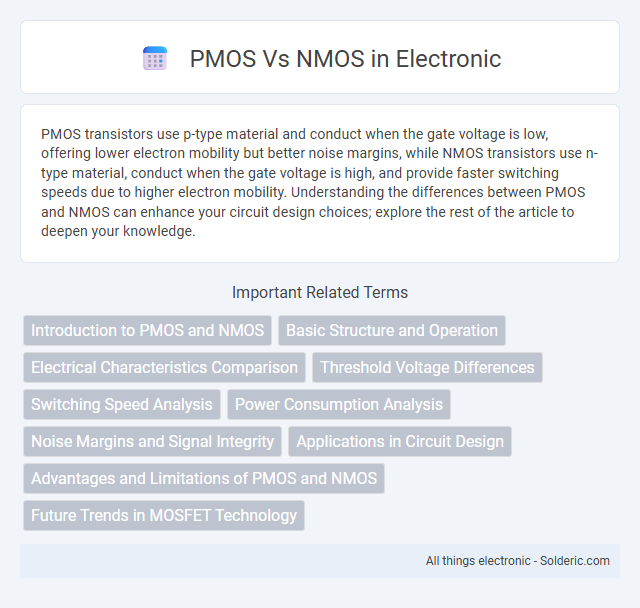PMOS transistors use p-type material and conduct when the gate voltage is low, offering lower electron mobility but better noise margins, while NMOS transistors use n-type material, conduct when the gate voltage is high, and provide faster switching speeds due to higher electron mobility. Understanding the differences between PMOS and NMOS can enhance your circuit design choices; explore the rest of the article to deepen your knowledge.
Comparison Table
| Feature | PMOS | NMOS |
|---|---|---|
| Carrier Type | Holes | Electrons |
| Mobility | Lower (approx. 2-3 times less) | Higher |
| Threshold Voltage | Negative | Positive |
| Switching Speed | Slower | Faster |
| Power Consumption | Higher in logic circuits | Lower in logic circuits |
| Symbol | Arrow pointing out of transistor body | Arrow pointing into transistor body |
| Channel Type | P-type | N-type |
| Common Use | Pull-up networks in CMOS | Pull-down networks in CMOS |
| Fabrication Cost | Generally higher due to lower mobility | Lower |
Introduction to PMOS and NMOS
PMOS (P-channel Metal-Oxide-Semiconductor) and NMOS (N-channel Metal-Oxide-Semiconductor) are fundamental transistor types used in CMOS technology for digital circuits. PMOS transistors conduct when the gate voltage is lower than the source, relying on positive charge carriers (holes), while NMOS transistors conduct when the gate voltage is higher than the source, using electrons as charge carriers. The complementary operation of PMOS and NMOS devices enables low-power and high-speed logic circuit designs widely used in microprocessors and memory chips.
Basic Structure and Operation
PMOS transistors consist of a p-type channel between two n-type regions, using a negative gate voltage to create a conductive path, while NMOS transistors have an n-type channel between two p-type regions and use a positive gate voltage for conduction. The basic operation of PMOS involves holes as majority carriers, leading to slower switching speeds compared to NMOS, which relies on electrons as majority carriers. Understanding the structural differences helps you optimize transistor selection based on speed and power efficiency requirements.
Electrical Characteristics Comparison
PMOS transistors exhibit higher threshold voltages and lower electron mobility compared to NMOS devices, resulting in slower switching speeds and reduced drive current. NMOS transistors provide better conductivity and faster operation due to the higher mobility of electrons, which enhances their efficiency in digital circuits. The electrical characteristics of PMOS and NMOS directly influence power consumption and switching behavior in CMOS technology applications.
Threshold Voltage Differences
PMOS transistors typically have a threshold voltage (Vth) that is negative, ranging from approximately -0.7V to -1.0V, whereas NMOS transistors possess a positive threshold voltage generally between +0.2V and +0.7V. This difference in threshold voltage arises from the type of charge carriers involved: holes in PMOS devices and electrons in NMOS devices, influencing their conduction onset. The disparity in Vth impacts circuit design, affecting switching speeds, power consumption, and noise margins in complementary metal-oxide-semiconductor (CMOS) technology.
Switching Speed Analysis
NMOS transistors typically exhibit faster switching speeds than PMOS due to higher electron mobility, enabling quicker charge carrier movement and reduced propagation delay in digital circuits. PMOS devices, characterized by lower hole mobility, generally switch slower, impacting overall circuit performance in high-speed applications. Understanding these differences helps optimize your design for power efficiency and speed by strategically balancing NMOS and PMOS transistors in complementary MOS (CMOS) technology.
Power Consumption Analysis
PMOS transistors consume less static power due to lower leakage currents compared to NMOS devices, making them more efficient in low-power applications. NMOS transistors exhibit higher electron mobility, resulting in faster switching speeds but increased dynamic power consumption during operation. Your circuit design can optimize power efficiency by balancing the use of PMOS for static stages and NMOS for speed-critical paths.
Noise Margins and Signal Integrity
PMOS transistors typically exhibit higher noise margins for low-level signals due to their strong pull-up capability, enhancing signal integrity in the high state, while NMOS devices excel in pulling signals down to ground with faster switching speeds. Your circuit design benefits from combining PMOS and NMOS in CMOS technology, which optimizes noise margins by leveraging complementary strengths to maintain signal stability and reduce voltage noise susceptibility. Careful transistor sizing and layout further improve signal integrity by minimizing threshold voltage variations and ensuring robust noise immunity across varying operating conditions.
Applications in Circuit Design
PMOS transistors are typically used in the pull-up network of CMOS circuits due to their strong ability to connect to VDD, offering low power consumption for logic high states. NMOS transistors excel in the pull-down network by efficiently switching to ground, enabling faster switching speeds and higher drive currents in digital circuits. Your circuit designs benefit from combining both PMOS and NMOS transistors in complementary configurations to achieve optimal trade-offs between power, speed, and noise margins.
Advantages and Limitations of PMOS and NMOS
PMOS transistors offer high noise immunity and better performance in high-voltage applications but exhibit slower switching speeds and higher power consumption compared to NMOS devices. NMOS transistors provide faster electron mobility, enabling higher switching speeds and lower on-resistance, which improves overall efficiency in digital circuits. However, NMOS devices are more susceptible to noise and typically require a higher threshold voltage, limiting their effectiveness in low-power or low-voltage environments.
Future Trends in MOSFET Technology
Future trends in MOSFET technology highlight NMOS devices for their higher electron mobility, enabling faster switching speeds and improved performance in digital circuits. PMOS transistors, favored for their superior hole mobility, are evolving to enhance complementary metal-oxide-semiconductor (CMOS) design efficiency and reduce power consumption. Your next-generation semiconductor projects will benefit from advancements in heterostructure engineering and gate dielectric materials, driving the scalability and reliability of both PMOS and NMOS devices.
PMOS vs NMOS Infographic

 solderic.com
solderic.com